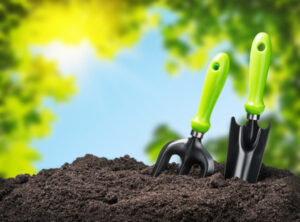From the You-Don’t-Need-to-Buy Files: Homemade Potting Soil

Sure, those monster-sized bags of potting soil are convenient, but they aren’t necessary. Gardeners of any level can easily make his or her own homemade potting soil by following a few steps.
First, let’s go over what you need to make your own potting soil. Your homemade potting soil’s main “ingredients” are the following:
– Dirt
– Well-aged compost
That’s the basic recipe!
Of course, you can add a few more organic components to give your homemade potting soil a little somethin’. Mother Earth News suggests adding in some leaf mold, and rotted sawdust from untreated wood, “A 4-by-5-foot pile of chopped leaves will take about two years to decompose into leaf mold. In areas where organic rice or other grain hulls are available, composting them will create a light material for fluffing up potting soil.”
The components mentioned above are similar to the peat moss, perlite, and vermiculite found in store-bought potting soil. All of these ingredients contribute to “land degradation and pollution” because they are “mined, processed, packaged, and shipped” to get to their destination.
If you’d like to take your homemade compost to the next level, consider adding “live compost” or “biologically active garden soil” to the mix. If you choose to add this component to your soil, you’ll need to complete the following steps:
Screening: According to Rodale’s Organic Life, a compost screener “allows gardeners to remove the chunky, unfinished bits from compost that is to be used in potting mixes or as a soil amendment or topdressing.”
Mother Earth News says to use a compost screen that’s a “half-inch of plastic fencing stapled to two piece of scrap lumber.” The benefit of screened compost is that when it stays lightly moist, it can continue to cure and improve with age. Once you’ve screened your compost, place it in bins or bags.
Heat-treating (pasteurizing): The MEN author suggests heating your compost to 160-180 degrees Fahrenheit:
“Numerous studies have shown that pasteurization, which involves heating compost or soil to 160 degrees for an hour, or 180 degrees for 30 minutes, kills a high percentage of all fungi and bacteria (the good and the bad), while preserving the biological integrity of the material — and its ability to suppress other diseases. Pasteurization kills persistent insects such as fungus gnats, too, along with all but a few heat-resistant weed seeds. The temperature must not go above 190 degrees, which can result in the formation of compounds that hinder plant growth.”
You can achieve this heat by making a solar cooker, or by heating in the oven.
Related on Organic Authority
The 411 on DIY Organic Potting Soil for the Resilient Container Garden
Hold the Herbicides: Testing for Soil Contamination
7 Steps to Starting a Garden with Seedlings in Toilet Paper Rolls
Soil image via Shutterstock

